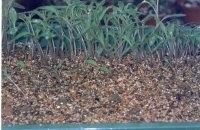Vermiculite G
Vermiculite G as a universal product for ecological gardening

Vermiculite G has comparison to Isoperl® G an increased water absorption capacity (approx. 300%) and is therefore suitable for plants with a very high water requirement or cultures with longer watering cycles.
Mix Vermiculite G at an appropriate ratio with your plant soil - up to 50% in extreme cases. Adding super phosphate and lime increases growth and the general health condition of all plants.
Loosen the soil, and mix Vermiculite G according to the characteristics (15-50%), water, plant and monitor adding fertiliser if necessary.
Moisten the mixture and fill your germination boxes with it, sow them and moisten as required.
Monitor the seeds, and don't forget than too much moisture is just as damaging as too little.
Possible mixture for young plant cultivation:
50% turf, 50% Vermiculite G granulation 2,
0.9 kg potassium nitrate, 0.6 kg super phosphate, 3.0 kg lime
Special note:
Excessive compression and addition of water can falsify the result. Vermiculite G cannot be too heavily pressed.
Advantages of Vermiculite G
Aggregate for improving pot and container substrates
- A natural mineral - free of germs and neutral (pH-7)
- For your plants at each stage of growth
- For improvement, loosening and temperature control of your soils
- Not just for loosening, but for controlling the water level
- To reduce water in young plant cultivation
- To reduce the costs of fertiliser and watering
- To reduce black rot
- To cover soil pots
- Clean to work with, earth coloured and unobtrusive, absorbs and stores excess nutrients
- Low-volume weight (approx. 8-10 kg/100 litres)
Use Vermiculite G! The success will prove you are right!
Vermiculite G improves the quality of any soil!
- Vermiculite G stores water
- Vermiculite G stores air
- Vermiculite G exchanges ions
- Vermiculite G improves the structure
- Vermiculite G stores nutrients
- Vermiculite G provides trace elements
Vermiculite G is from nature for nature
... for sowing special cultures
Germinating seeds need lots of oxygen as well as moisture for intensive respiration and energy conversion processes. Vermiculite G corresponds with these requirements and is also germ-free. Cover the seeds with Vermiculite G and mix 10-20% with the sowing soil.
... for mixture in germinating soils
Vermiculite G helps young plants to gradually get used to heavier substances. Vermiculite G can be mixed with the soil at a ratio of 1:1.
... for NFT nutrient film technology
Vermiculite G as a substrate in containers (plastic sack, tray etc.), filled and supplied with a controlled nutrient solution, are suitable for soil independent cultures (hydroculture).
... as an aggregate for the improvement of soil substrates
Vermiculite G increases the water and air capacity and the ability to exchange nutrient ions, gives the soil and loose structure and sustainably supplies the plants with trace elements. Vermiculite G is particularly recommended for mixing with compost soils and to pure turf substrates at a ratio of 10 - 30%.
... for reproduction of cuttings
Fill the reproduction beds or containers with Vermiculite G, water and lightly insert the cuttings. Due to the high water capacity, the cuttings are supplied evenly with moisture while the large pore volume prevents rotting. As soon as the cuttings have taken root, liquid fertiliser can be added. The high ion exchange capacity protects the sensitive roots against excessively high salt concentrations.
... for quick composting
Vermiculite G binds the moisture. Organic waste is dried out and the multiplication of microorganisms (which trigger allergies and other illnesses) are heavily reduced and the development of odour is minimised. With Vermiculite G, the soil is loosened and aired so that good and quick waste decomposition takes place.
Properties
Vermiculite G is an accordion-like granulate with millions of tiny layers of air in which water and especially nutrient ions can be stored and given to the plant roots as required (makes a significant contribution to the fertility of the soil by exchanging ions).
Physical properties
| Hardness | 1.5 - 3 n.d. Moh scale |
|---|---|
| Granulation | K0, K1, K2, K3, K4 |
| Vol. weight dry | 70-160 g/l |
| Vol. weight moist | 427 - 450 g/l |
| Water content at water saturation | 449 - 531 ml/l |
| Air content at water saturation | 408 - 503 ml/l |
| Pore volume | 939 - 952 ml/l |
Chemical properties
Vermiculite G is an aluminium-iron-magnesium-silicate, which belongs to the mica group. IT contains lots of valuable minerals and supplies the plants with trace elements, especially with iron, silicon and magnesium.
| PH value | approx. 7,5 |
|---|---|
| KAK (cation exchange capacity) | 70 mmol/z/100g Vermiculite |
Chemical average analysis
| V2O3 | traces | |
|---|---|---|
| SiO2 | 35-41% | |
| P2O5 | 0,2-2% | |
| Al2O3 | 6-9,5% | |
| Li2O | 0,03% | |
| TiO2 | 0,6-1,4% | |
| ZrO2 | traces | |
| Fe2O3 | 6-9,5% | |
| Cr2O3 | 0,01-0,15 | |
| FeO | 1,17% | |
| MuO | 0,30% | |
| NiO | traces | |
| MgO | 21,5-25,5% | |
| CoO | traces | |
| CaO | 2-6% | |
| BaO | traces | |
| Na2O | 0,80% | |
| F | 0,2-0,8% | |
| K2O | 3-6% | |
| SO3 | 0,02% | |
| S | 0,18% | |
| H2O + 105 C | 5,18% | |
| Cl | 0-0,5% | |
| H2O - 105 C | 6,02% |





